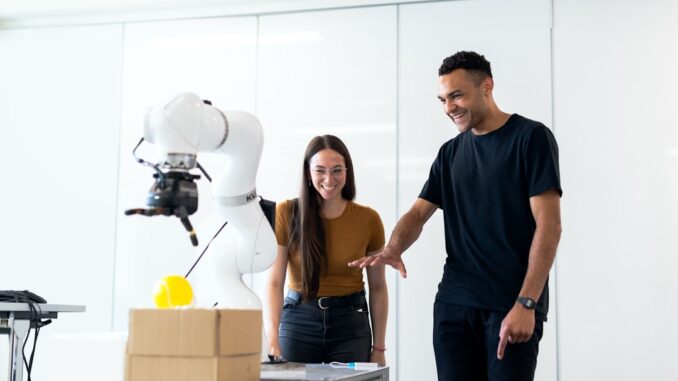
Summary
Johnson & Johnson MedTech has successfully completed the first clinical trials of its highly anticipated Ottava surgical robot. The robot, designed for minimally invasive procedures, boasts innovative features like retractable arms and seamless integration with existing surgical tools. This marks a major advancement in robotic surgery and could revolutionize how various procedures are performed.
Secure patient data with ease. See how TrueNAS offers self-healing data protection.
** Main Story**
Okay, so J&J’s Ottava robot just completed its first clinical surgeries. It’s kind of a big deal, potentially shaking up how minimally invasive surgeries are done. Think about it: a new player stepping into the robotic surgery arena, ready to challenge the status quo.
The initial surgeries? Roux-en-Y gastric bypasses, performed by Dr. Erik Wilson at UT Health Houston. It’s exciting, honestly. The first real-world test for the Ottava. Assuming it gets FDA approval, and it probably will, this could open doors for wider use. As Dr. Wilson put it himself, surgical robotics are at the forefront. He’s proud to be on the front lines of this, helping push the boundaries.
What Makes Ottava Different?
What’s cool about Ottava is that it’s designed to fix some of the problems that existing robots have. Things like precision, efficiency, and the range of surgeries they can handle.
-
Dexterity and Flexibility: Ottava has four robotic arms, and get this—they’re integrated right into the operating table. I mean, how slick is that? It allows for better movement and flexibility, giving surgeons more control. You know, kinda like when you’re trying to reach that one stubborn bolt in your car engine, and nothing quite gets the right angle? This solves that problem in the OR.
-
Space-Saving Design: Space in an OR is precious. The genius part? When Ottava’s not in use, those arms tuck away under the table. Less clutter, easier for the surgical team to move around. It’s like having a power tool that folds neatly into its case when you’re done.
-
Seamless Integration: Ottava works with J&J’s Ethicon surgical instruments. This is smart. Surgeons can keep using the tools they’re comfortable with. Makes switching to robotic-assisted procedures way easier.
-
Advanced Digital Ecosystem: The Ottava’s tied into the Polyphonic digital system. Translation: It connects all sorts of surgical tech, robotics, and software. That means data sharing, analysis, and, ultimately, better decision-making for surgeons. It’s like having a heads-up display for the entire surgical process.
What’s Next?
The data from these surgeries is key. J&J will use it to apply for FDA approval. They’re aiming for a green light on a bunch of general surgery procedures, from gastric bypass to hiatal hernia repair.
It’s worth noting that J&J isn’t new to robotics. They already have the Monarch for lung biopsies and the Velys for orthopedics. With Ottava, they’re going head-to-head with the big boys, like Intuitive Surgical (makers of the da Vinci) and other up-and-comers. Can they actually compete? Maybe. Ottava’s successful surgeries are a big win for J&J, bringing them closer to becoming a real end-to-end robotic surgery provider for hospitals and patients, so this isn’t their first rodeo.
The Bigger Picture
Ottava is just one piece of the puzzle. Medical tech is exploding, and the stuff we will see in the coming years will astound us. We are seeing virtual reality for surgical training, telemedicine for remote care, wearables tracking health, 3D-printed implants, and AI helping with diagnoses. It’s about making healthcare better, more efficient, and more accessible for everyone. So, you know, it’s not just about robots; it’s about transforming the whole system. What kind of possibilities will there be as we move closer to having a complete, digitized picture of patients?
Honestly, it’s an exciting time to be in this industry. Though, sometimes I feel like I’m in a science fiction movie, I’m not sure what the future holds. It can’t be denied the future has some exciting possibilities.


The integration of the Polyphonic digital system seems promising for data sharing and analysis. Considering the increasing focus on personalized medicine, how might this system be further developed to leverage patient-specific data for optimizing surgical plans and predicting outcomes?
That’s a great point! The potential for personalized medicine is huge. Imagine Polyphonic incorporating real-time patient data – like vital signs and even pre-operative genetic markers – to dynamically adjust the surgical plan during the procedure. This could lead to more precise and effective outcomes. What other data points do you think would be most valuable?
Editor: MedTechNews.Uk
Thank you to our Sponsor Esdebe
Given the integrated design of Ottava’s robotic arms within the operating table, how does this impact workflow efficiency for surgical teams, particularly during complex or emergency procedures requiring swift adjustments?
That’s a really insightful question! The integrated design aims to streamline workflow, and I agree that swift adjustments are critical, especially in emergencies. Johnson and Johnson MedTech say the tuck-away arm design and seamless integration with existing tools are designed to help in these events, allowing for rapid transitions between robotic and traditional surgery. We will follow to see how this holds up in real world use cases.
Editor: MedTechNews.Uk
Thank you to our Sponsor Esdebe
The integration of the Polyphonic digital system is a key differentiator. Connecting surgical tech and software for data sharing could significantly improve real-time decision-making. How might AI further enhance this ecosystem by predicting potential complications during procedures?